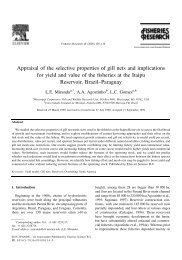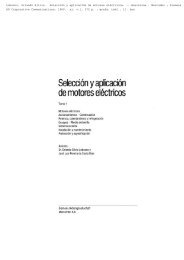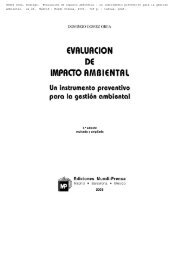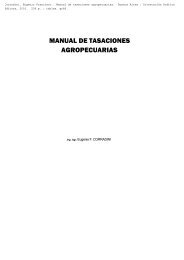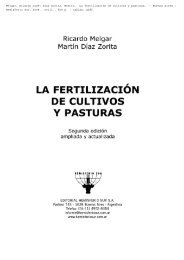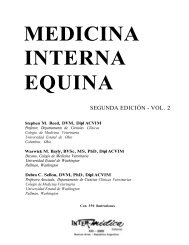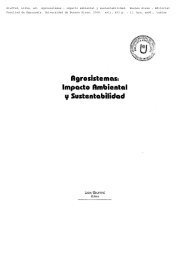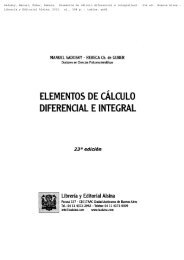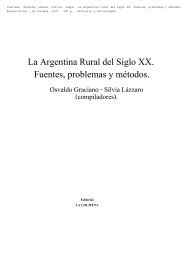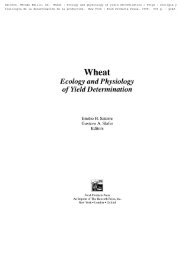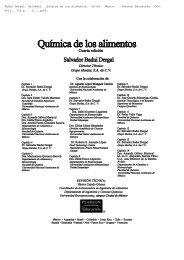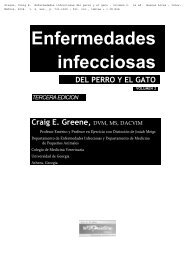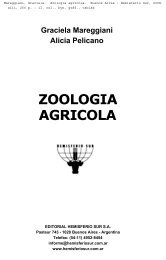Electrophoretic characterization of Amaranthus L. seed proteins and ...
Electrophoretic characterization of Amaranthus L. seed proteins and ...
Electrophoretic characterization of Amaranthus L. seed proteins and ...
Create successful ePaper yourself
Turn your PDF publications into a flip-book with our unique Google optimized e-Paper software.
62 R. JUAN ET AL.ACKNOWLEDGEMENTSWe thank M. Dolores Garcia for technical assistance.This work was supported by grant AGL 2004-03930.REFERENCESAbugoch LE, Martinez NE, Añón MC. 2003. Influence <strong>of</strong>the extracting solvent upon the structural properties <strong>of</strong>amaranth (<strong>Amaranthus</strong> hypochondriacus) glutelin. Journal<strong>of</strong> Agriculture <strong>and</strong> Food Chemistry 51: 4060–4065.Aellen P. 1959. <strong>Amaranthus</strong> L. In: Hegi G, ed. Illustrierteflora von Mitteleuropa, Vol. 2. München: Carl HanserVerlag, 465–516.Aiassa JP, Bonamico NC, Ibañez MC, Díaz DG,Gesumaría JJ, Di Renzo MA. 2003. Caracterizaciónmolecular de híbridos simples de maíz (Zea mays L.) medianteSSR. In: XXXII Congreso Argentino de Genética,Huerta Gr<strong>and</strong>e, Septiembre, 2003. Córdoba: Sociedad Argentinade Genética, 21–24.Altube H, Cabello F, Ortiz JM. 1991. Characterization <strong>of</strong>grape varieties <strong>and</strong> rootstocks by isoenzymes from woodyparts. Vitis 30: 203–212.Barba de la Rosa AP, Gueguen J, Paredes-López O,Viroben G. 1992. Fractionation procedures, electrophoretic<strong>characterization</strong>, <strong>and</strong> amino acid composition <strong>of</strong> amaranth<strong>seed</strong> <strong>proteins</strong>. Journal <strong>of</strong> Agricultural <strong>and</strong> Food Chemistry40: 931–936.Bradford MM. 1976. A rapid <strong>and</strong> sensitive method for thequantitation <strong>of</strong> microgram quantities <strong>of</strong> protein utilizing theprinciple <strong>of</strong> protein–dye binding. Analytical Biochemistry72: 248–254.Bravi R, Sommovigo A, Delogu C, Merisio G. 1994. Investigationon <strong>seed</strong> species identity <strong>of</strong> Lolium rigidum tradingin Italy. Sementi Elette 40: 11–17.Bray RJ, Curtis JI. 1957. An ordination <strong>of</strong> the upl<strong>and</strong> forestcommunities <strong>of</strong> southern Wisconsin. Ecological Monographs27: 325–349.Brenan JPM. 1961. <strong>Amaranthus</strong> in Britain. Watsonia 4:261–280.Bressani R. 1989. The <strong>proteins</strong> <strong>of</strong> grain amaranth. FoodResearch International 5: 13–38.Bressani R, García-Vela LA. 1990. Protein fractions inamaranth grain <strong>and</strong> their chemical <strong>characterization</strong>.Journal <strong>of</strong> Agricultural <strong>and</strong> Food Chemistry 38: 1205–1209.Búcaro-Segura ME, Bressani R. 2002. Distribución de laproteína en fracciones físicas de la molienda y tamizado delgrano del amaranto. Archivos Latinoamericanos de Nutrición52: 167–171.Carretero JL. 1979. El género <strong>Amaranthus</strong> en España. CollectaneaBotanica 11: 105–145.Carretero JL. 1990. <strong>Amaranthus</strong>. In: Castroviejo S, LainzM, López González G, Montserrat P, Muñoz Garmendia F,Paiva J, Villar L, eds. Flora Iberica plantas vasculares de laPenínsula Ibérica e Islas Baleares, Vol. 2. Madrid: RealJardín Botánico, C.S.I.C., 554–569.Chan KF, Sun M. 1997. Genetic diversity <strong>and</strong> relationshipsdetected by isozyme <strong>and</strong> RAPD analysis <strong>of</strong> crop <strong>and</strong> wildspecies <strong>of</strong> <strong>Amaranthus</strong>. Theoretical <strong>and</strong> Applied Genetics 95:865–873.Costea M, DeMason DA. 2001. Stem morphology <strong>and</strong>anatomy in <strong>Amaranthus</strong> L. (Amaranthaceae) – taxonomicsignificance. Journal <strong>of</strong> the Torrey Botanical Society 128:254–281.Costea M, S<strong>and</strong>ers A, Waines G. 2001a. Preliminary resultstoward a revision <strong>of</strong> the <strong>Amaranthus</strong> hybridus speciescomplex (Amaranthacaea). Sida 19: 931–974.Costea M, Waines G, S<strong>and</strong>ers A. 2001b. Structure <strong>of</strong> thepericarp in some <strong>Amaranthus</strong> L. (Amaranthaceae) species<strong>and</strong> its taxonomic significance. Aliso 20: 51–60.Costea M, Weaver SE, Tardif FJ. 2004. The biology <strong>of</strong>Canadian weeds. 130. <strong>Amaranthus</strong> retr<strong>of</strong>lexus L., A. powelliiS. Watson <strong>and</strong> A. hybridus L. Canadian Journal <strong>of</strong> PlantScience 84: 631–668.Dehmer KJ. 2003. Molecular diversity in the genus <strong>Amaranthus</strong>.In: Knüpffer H, Ochsmann J, eds. Schriften zuGenetischen Ressourcen, B<strong>and</strong> 22. Bonn: Rudolf Mansfeld<strong>and</strong> Plant Genetic Resources, 208–215.Drzewiecki J. 2001. Similarities <strong>and</strong> differences between<strong>Amaranthus</strong> species <strong>and</strong> cultivars <strong>and</strong> estimation<strong>of</strong> outcrossing rate on the basis <strong>of</strong> electrophoretic separations<strong>of</strong> urea-soluble <strong>seed</strong> <strong>proteins</strong>. Euphytica 119: 279–287.Duvall MR, Biesboer DD. 1989. Comparisons <strong>of</strong> electrophoretic<strong>seed</strong> protein pr<strong>of</strong>iles among North American populations<strong>of</strong> Zizania. Biochemical Systematics <strong>and</strong> Ecology 17:39–43.El Aydam M, Bürki HM. 1997. Biological control <strong>of</strong> noxiouspigweeds in Europe: a literature review <strong>of</strong> the insect speciesassociated with <strong>Amaranthus</strong> spp. worldwide. BiocontrolNews <strong>and</strong> Information 18: 11–20.Esparza-S<strong>and</strong>oval S, Alej<strong>and</strong>re-Iturbide G, Herrera-Arrieta Y. 1996. Foliar anatomy <strong>and</strong> morphology <strong>of</strong> <strong>seed</strong>sin some Mexican species <strong>of</strong> <strong>Amaranthus</strong>. Phytologia 81:273–281.Gardiner SE, Forde MB. 1987. Sds polyacrylamide gelelectrophoresis <strong>of</strong> grass <strong>seed</strong> <strong>proteins</strong>: a method for cultivaridentification <strong>of</strong> pasture grasses. Seed Science <strong>and</strong> Technology15: 663–674.Gardiner SE, Forde MB. 1988. Identification <strong>of</strong> cultivars<strong>and</strong> species <strong>of</strong> pasture legumes by sodium dodecyl sulphatepolyacrylamide gel electrophoresis <strong>of</strong> <strong>seed</strong> <strong>proteins</strong>. PlantVarieties Seeds 1: 13–26.Gardiner SE, Forde MB, Slack CR. 1986. Grass cultivaridentification by sodium dodecylsulphate polyacrylamide gelelectrophoresis. New Zeal<strong>and</strong> Journal <strong>of</strong> AgriculturalResearch 29: 193–206.Gorinstein S, Delgado-Licon E, Pawelzik E, HeriyatiPerm<strong>and</strong>y H, Weisz M, Trakhtenberg S. 2001. Characterization<strong>of</strong> soluble amaranth <strong>and</strong> soybean protein basedon fluorescence, hydrophobicity, electrophoresis, amino acidanalysis, circular dichroism, <strong>and</strong> differential scanning calorimetrymeasurements. Journal <strong>of</strong> Agricultural <strong>and</strong> FoodChemistry 49: 5595–5601.Gorinstein S, Moshe R. 1991. Evaluation <strong>of</strong> four <strong>Amaranthus</strong>species through protein electrophoretic patterns <strong>and</strong>© 2007 The Linnean Society <strong>of</strong> London, Botanical Journal <strong>of</strong> the Linnean Society, 2007, 155, 57–63



